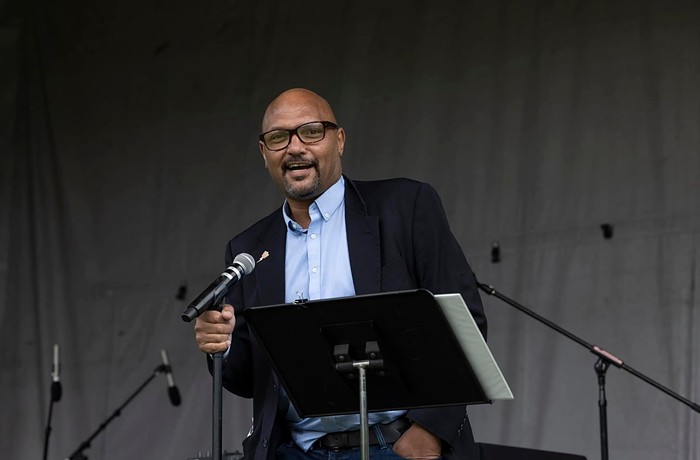THIS STORY BEGINS with its own ending, so I can't reveal exactly how we got the idea. It starts with my friend Alan, and Alan is very loyal to his purveyors. For nearly four years he has sung to me—personally, via email, and now, occasionally, in those light afternoon dreams—the praises of a particular shop's beef. I wave him off, I nod, and I tell him to cook me some. He'll text me a picture of a glistening, beautifully marbled raw steak, but then quickly text to say that he and his children have just eaten all of it. "You should really try this stuff sometime," he'll say.
When the Mercury's Alcoholgonquin Round Table sent forth the dictum to plan a summer grilling issue, it was clearly time to put Alan's ceaseless chirruping to the test. I would gather a standard cut of beef (rib-eye, where price and flavor intersect), pick it up from as many sources as I could afford, including Alan's, and arrange a blind taste test among the most qualified individuals I could gather. I would conduct the test at Ox, our venerated shrine to grilled meat, and Ox chef/owner Gregory Denton himself would flip and cook the cuts to a photogenic, rosy medium rare.
For the tasting, I corralled the services of Denton, Jason French (chef/owner of Ned Ludd), Lucian Prellwitz (sous chef, Ned Ludd), Eric Finley (owner/head charcutier of Chop Butchery and Charcuterie), Nick the Booze Guy, and, of course, Alan, who was nearly beside himself with glee as he walked through the hallowed doors of Ox that afternoon. Nine purveyors were represented, and care was taken to purchase meat from shops to which we all have access (as well as some we don't). Fred Meyer, Safeway, and Trader Joe's meat would share the grill with Estancia (Argentinean—Ox's own preferred provider, via Nicky USA) and other cuts only available to restaurants.
Many cooks will tell you that meat cooked on the bone is superior, but bone-in rib-eye is far less commonly available to the consumer, so boneless rib-eye it was. Besides, authoritative information proving this claim is as rare and unpersuasive as that for the old saw "searing seals the juices in." Harold McGee himself, in On Food and Cooking, cites only the insulative—not flavoring—properties of bone, which leads to meat that's simply had less opportunity to be ruined by the cook. J. Kenji López-Alt, of seriouseats.com, debunks the claim outright (and paraphrases generously from McGee, too, I discovered) in an informative and straightforward test-kitchen article that is easily found online.
Steaks were grilled in groups of three, and labeled Exhibits A through I. Only I knew which was which, so, having recused myself all the way down to "well-fed onlooker" status, I set a palate-cleansing Braeburn apple before each tester and bid them good eating. Chef Denton lightly applied a nearly flavorless 75 percent canola/25 percent olive oil blend to each steak to keep it from sticking to the grill, lightly salted them, and gave them a few minutes of 900-degree what-for on each side before resting them briefly and slicing them for the tasters. They were gratifyingly quiet and thoughtful as they completed their remarks—on the simplified score sheet you see before you—within three minutes of the beef leaving the heat. These are people, after all, who live and die by their product, their palate, and the shared vocabulary with which they codify such things. Their score sheets, unlike mine, didn't feature the word "Manly!" underlined three times, next to another square with "Ox" written in bubble letters. These were professionals, and they were behaving that way.
In the end, three rounds of three steaks each were sampled and re-sampled, 81 units of data were collected, and after personal deliberation, the rankings were assigned and handed in. The princes and the paupers of the beef world had been tried in the dark, with no grade, brand name, or fancy import title to predispose anyone in their favor. Who took top honors?
Alan's steak, of course. Costco Kirkland Signature USDA prime-grade American-raised rib-eye, $13.99/pound, AKA Test Steak H, was nearly unanimously chosen ahead of Niman Prime, Estancia, and other meat you're paying three dollars an ounce for wherever your waiter's pushing the "big cabs." Comments for this steak—which was eaten second to last, in the "beef-fatigue danger zone"—immediately went from perfunctory terms like "good" or "meh" into poetic territory, with adjectives like "buttery," "grassy," "complex, with light minerality," and "close to love." The second favorite, and an absolutely beautiful product that scored closely to the first, was the Niman prime, available at Chop and Laurelhurst Market.
Bottom honors went to Trader Joe's (Mexican beef) and Painted Hills (from the Pacific Northwest, and privately ordered), with Fred Meyer skirting the shame party in the way he always seems to do. Notes for these steaks read on the order of "fart," "I feel sorry for the cow," and "this saddens me." (Okay, so some unscientific language was used, but knowing the cooks I do, I'd hardly call it unprofessional.)
When Alan and I are old and crooked and babbling at each other from our rattan-backed wheelchairs in the asylum, this event will likely find a way to enter a disproportionate number of conversations. That is fine. The takeaway is worth it: Despite what I had once suspected, the best beef does not go only to restaurants, or command the highest price. You can, in fact, pick it up the next time you need to buy your engagement ring, a shrink-wrapped case of Malibu handles, and a set of Toyo radials all in the same place, on the same trip. A rare victory of quality for big-box buying power.













